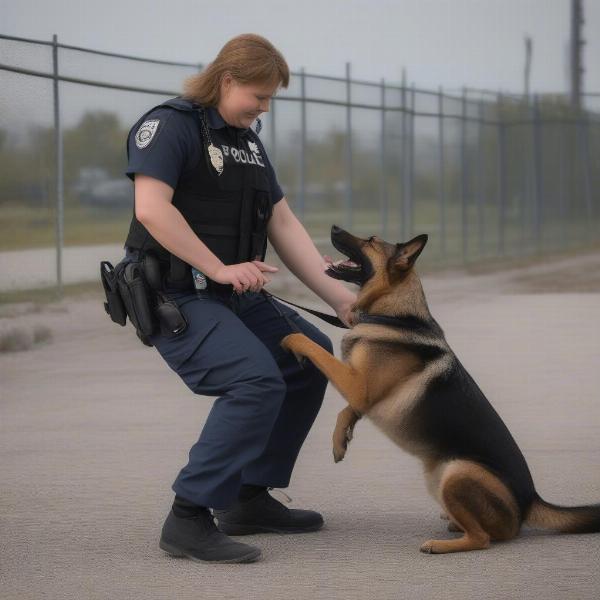Police dog training is a rigorous and specialized process that transforms ordinary dogs into highly skilled partners in law enforcement. This guide delves into the world of police dog training, exploring the selection process, training methods, and the vital roles these canine officers play in keeping our communities safe. From selecting the right breed to mastering complex commands, we’ll cover everything you need to know about this fascinating field.
Selecting the Right Breed for Police Work
Certain breeds are naturally predisposed to the demands of police work. German Shepherds, Belgian Malinois, and Dutch Shepherds are common choices due to their intelligence, athleticism, and trainability. Temperament is also crucial; police dogs must possess a stable and confident demeanor, demonstrating both courage and control.
The selection process is rigorous. Potential police dogs are assessed for their physical health, drive, and temperament through a series of tests. These tests evaluate the dog’s prey drive, ability to follow commands, and reaction to various stimuli. Only the dogs that exhibit the ideal combination of traits are chosen to begin their training journey.
The Stages of Police Dog Training
Police dog training is a multi-stage process that requires patience, consistency, and positive reinforcement. It begins with basic obedience training, where the dogs learn fundamental commands like sit, stay, and come. This foundation is essential for establishing control and building a strong bond between the dog and handler.
 Police Dog Basic Obedience Training
Police Dog Basic Obedience Training
Next comes specialized training, which focuses on specific tasks such as suspect apprehension, narcotics detection, and explosives detection. This training often involves the use of specialized equipment and realistic scenarios to prepare the dogs for real-world situations. For example, dogs trained in narcotics detection are exposed to various drug scents, while those trained in explosives detection learn to identify the unique odors of explosives.
The Vital Roles of Police Dogs
Police dogs play a crucial role in various law enforcement activities. Their keen senses and specialized training make them invaluable assets in:
- Suspect Apprehension: Police dogs can track and apprehend suspects, often in situations where human officers would be at greater risk.
- Narcotics Detection: Their highly sensitive noses can detect even trace amounts of illegal drugs, aiding in drug seizures and arrests.
- Explosives Detection: Police dogs are trained to locate explosives, helping to prevent terrorist attacks and ensure public safety.
- Search and Rescue: Their tracking abilities are also utilized in search and rescue operations, helping to locate missing persons and provide assistance in disaster relief.
Maintaining Peak Performance
Continuous training and reinforcement are essential for maintaining a police dog’s skills and ensuring their effectiveness in the field. Regular health checkups and a balanced diet are also crucial for their physical well-being. The bond between the dog and handler is paramount to their success, requiring constant communication and trust.
Conclusion
Police dog training is a demanding yet rewarding process that produces highly skilled canine officers. These dogs play a vital role in law enforcement, contributing to safer communities worldwide. From their rigorous selection process to their specialized training, police dogs represent a powerful partnership between humans and animals in the pursuit of justice and safety. Understanding the complexities of their training underscores the dedication and expertise required to develop these remarkable partners in law enforcement.
FAQ
- How long does it take to train a police dog? Training typically takes several months to a year, depending on the specific skills required.
- What breeds are commonly used as police dogs? German Shepherds, Belgian Malinois, and Dutch Shepherds are among the most popular breeds.
- What kind of specialized training do police dogs receive? Specialized training includes narcotics detection, explosives detection, suspect apprehension, and search and rescue.
- What is the role of positive reinforcement in police dog training? Positive reinforcement, such as praise and treats, is crucial for motivating the dogs and building a strong bond with their handlers.
- How are police dogs selected for training? Dogs are selected based on their physical health, temperament, drive, and ability to perform specific tasks.
- What is the importance of the bond between a police dog and its handler? The bond is essential for effective communication, trust, and successful performance in the field.
- How are police dogs cared for after they retire? Many police dogs retire with their handlers, becoming beloved family pets.
ILM Dog is a leading international website dedicated to providing comprehensive information and resources for dog owners and enthusiasts worldwide. We offer expert advice on various topics, including dog breeds, health, training, nutrition, grooming, and much more. We are committed to promoting responsible dog ownership and enhancing the bond between humans and their canine companions. For any inquiries or further information, please contact us at [email protected] or call us at +44 20-3965-8624. Visit ILM Dog for more valuable resources on dog care and training.